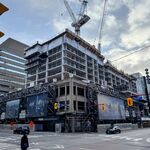Is it? The Liberals had an On-Corridor and an Off-Corridor package. The Off-corridor package was all about major station upgrades including platform height adjustments. The PC Party eliminated nearly the entire off-corridor package while keeping the on-corridor package largely unchanged AFAICS (despite being split-up and repackaged).
That said, passenger loading only causes significant dwell times at a small number of stations (like Union and Exhibition) both of which are getting significant modifications.
On Corr and Off Corr seem to be alive and well in public ML documentation, but you are correct that the station planning was pared back. If you recall the renders (they are way back in this thread, somewhere) for stations like Maple with a huge trainshed, that's probably a wise move. Certainly we won't see such grandiose Wynne/Del Duca branded stations under a development-driven station program, but station work that is mission critical is certainly continuing (Bramalea, Oriole, Agincourt, Milliken, Unionville, Weston, Mount Dennis, Woodbine, ......etc) and those stations are quite adequate in scale for their task.
One has to remember also that development funded stations get swept into the development application process for the overall development plan, and development applications are of necessity a multi year approval process. Look at Mimico as an example of that. So what may look like "cancel" is actually just "takes longer".
it would be interesting to know whether the spec's for development funded stations require roughing-in high level platforms.
As much as high level platforms are interesting, and may be essential some day, starting that program now would be a huge distraction and disruption to RER. It's enough just to get electrification started, tracks added, and 2WAD under way... without having that transition added to the scope. Let's talk about that in 2026 when RER construction is wrapping up.
I do think VIA could be allowed to build dedicated high level platforms at Union without impinging on GO. The new track arrangement may give GO enough capacity that it doesn't impact them adversely.
- Paul




